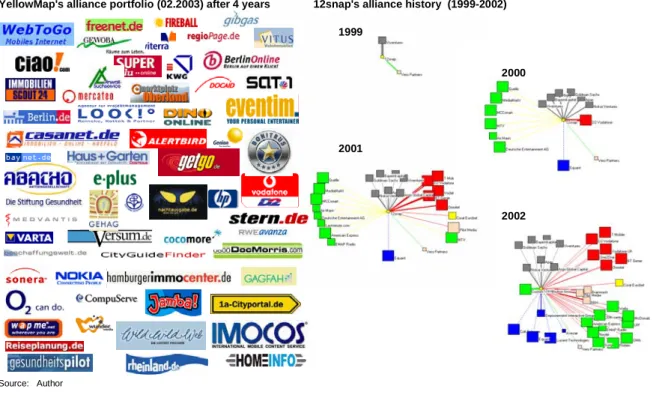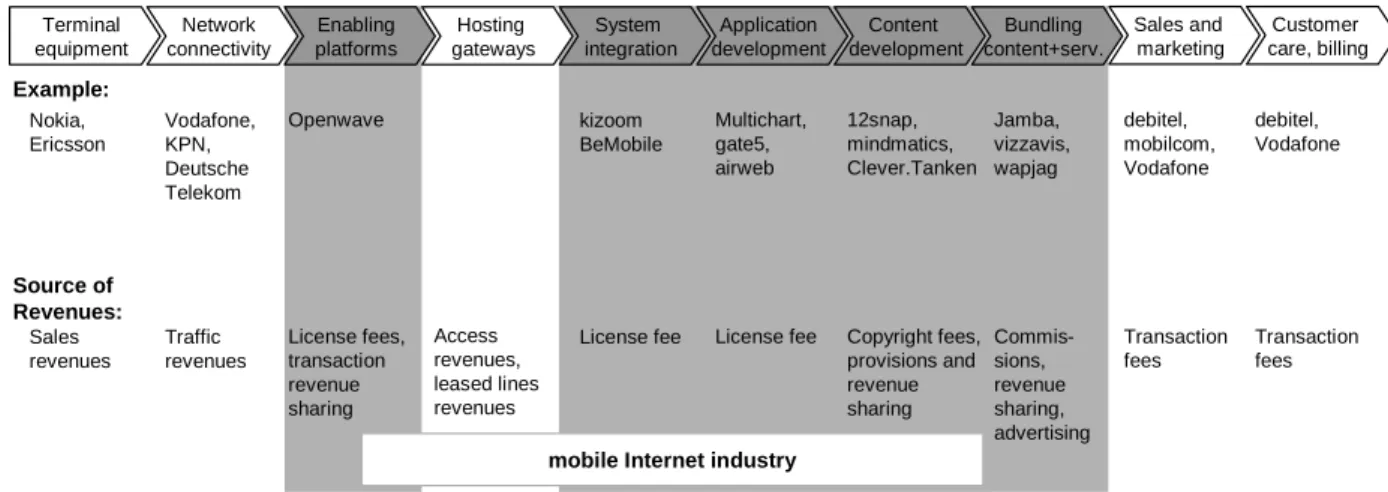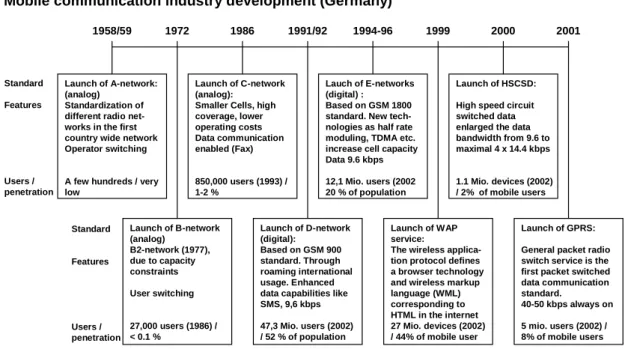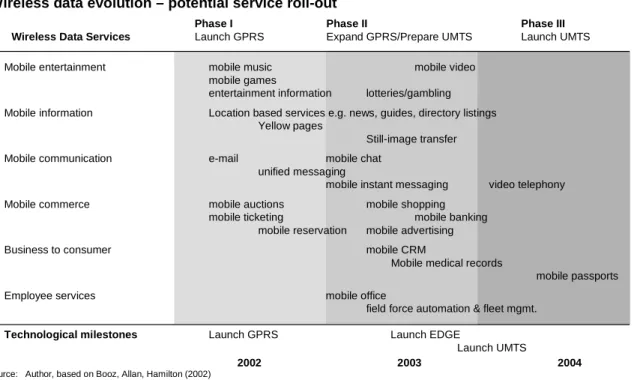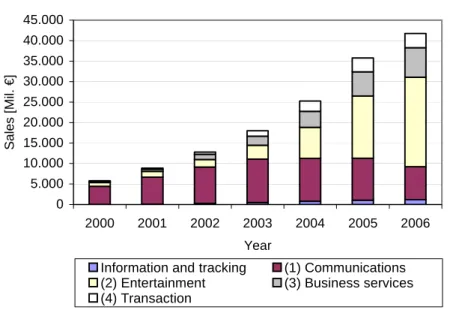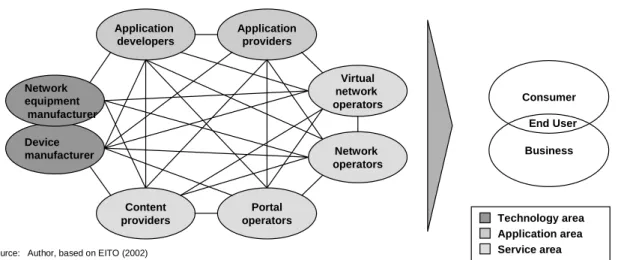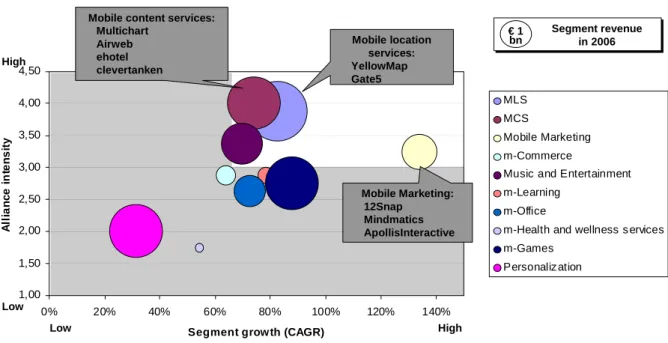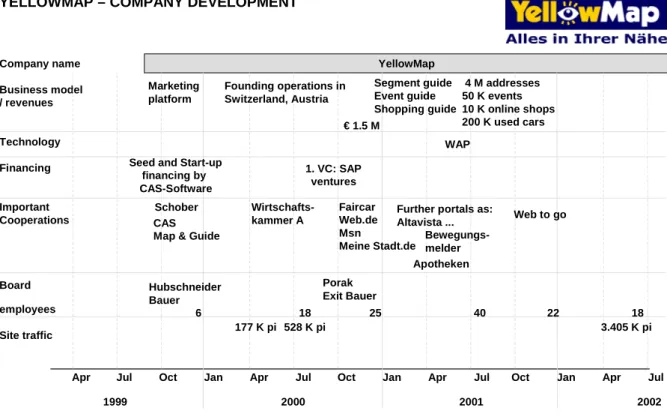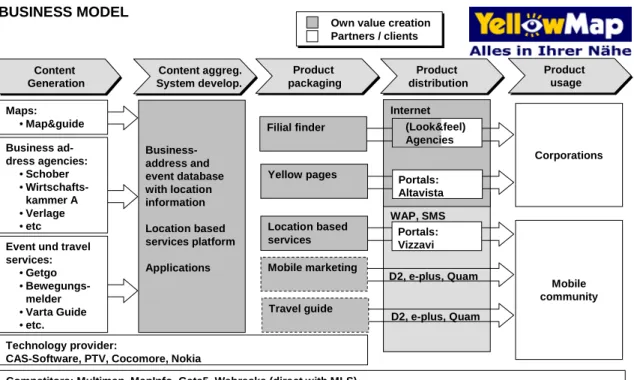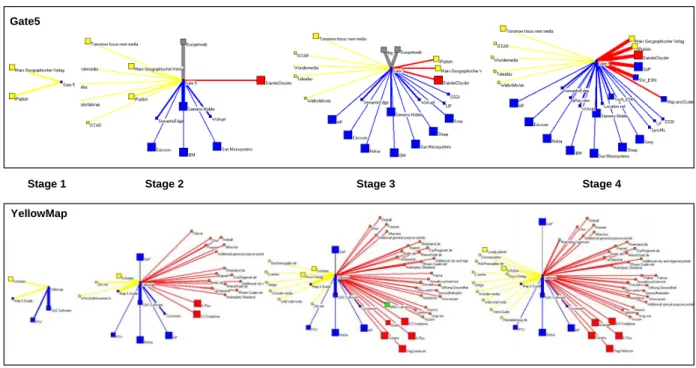C OEVOLUTION OF ALLIANCE PORTFOLIO AND ORGANIZATION OF NEW TECHNOLOGY - BASED FIRMS :
A
CASE STUDY OF THEM
OBILEI
NTERNET INDUSTRYDissertation
zur Erlangung des akademischen Grades doctor rerum politicarum
Vorgelegt an der Wirtschafts- und Sozialwissenschaftlichen Fakultät der Otto Friedrich Universität Bamberg
Tillmann L. von Schroeter
Gutachter:
1. Prof. Dr. Dodo zu Knyphausen-Aufseß 2. Prof. Dr. Peter Witt
Prüfungstermin:
25.11.2004
to my parents
ACKNOWLEDGEMENTS
I want to thank a number of individuals and organizations for their advice and support throughout this research project.
First, I would like to thank my academic advisor Dodo zu Knyphausen-Aufseß who, throughout our joint two years, supported this work in two ways. As regards content, his counsel set the basic direction of my work and strongly influenced the selection of a suitable research methodology; he shaped the overall ‘storyline’ of this research study with his challenging questions. His interest and openness allowed me to develop my own approaches and find “my way”. As regards the academic environment, Dodo zu Knyphausen-Aufseß’s enthusiasm and dedication was a cornerstone in initiating Exist-HighTEPP, an entrepreneurial research program in Bamberg, Germany. Exist-HighTEPP provided an excellent research environment here in Germany and funds for a visiting scholarship at the Wharton School.
In the US, I would like to thank Claus Rerup of the Wharton School for teaching me the necessary academic humility and ambition, and Simone Ferriani from the University of Bologna for the discussions concerning network and resource dependency theory and his thoughts on co-evolution of alliances and organizations. My understanding of strategic management and entrepreneurship has also greatly benefited from the insights I gained through many discussions at Wharton with Sidney Winter, Ian MacMillan, and Lori Rosenkopf. To all five, I would like to express my gratitude for taking the time to discuss my project with me. A special thanks to Ian MacMillan, who invited me to come to Wharton for four months. The exposure to the best research community in the world was inspiring and very helpful.
Concerning my understanding of the Mobile Internet Industry, I would like to thank Claudius Bertheau for four years of engaging discussions on market trends, technologies, and cooperations. These talks were essential for my understanding of business models, value chains, and alliances in this industry. In addition, his company Airweb served as a prototype case that was instrumental in crafting the research tools.
This study would not have been possible without the collaboration of nine mobile Internet companies: 12snap, Airweb, ApollisInteractive, Clever.Tanken, e-hotel, Gate5, Mindmatics, Multichart, and Yellowmap. I am grateful to the many executives for the time they gave to be interviewed, for the knowledge they shared with me, and for the trust they put in my work. I sincerely hope that the results of this study allow them to view their efforts as ‘good investments’. In observance of an old tradition, I acknowledge my full responsibility for the study, its conclusions, and its weaknesses.
I would like to thank my friends and colleagues in the Exist HighTEPP program, Nils Naujok, with whom I shared a room and had multiple discussions about the fundamental questions of alliances in the communication industry, and Sabine von Witzleben – managing assistant of the program – for streamlining my writing and for her élan, with which she introduced us to Frankonian culture. Last but not least I would like to thank Karsten Hoppe, who recruited me for the program and, as compensation for the many hours in front of our PCs, gave me good battles on the badminton court.
I would lastly like to thank my family and friends. A special thanks to my parents for their constant support over the past years and their lobbying for an academic career and to Saskia for the many inspiring hours and for her vitality, which gave me the power to focus on achieving this research project.
Berlin TILLMANN L. VON SCHROETER
October 2004
TABLE OF CONTENTS
page
1. INTRODUCTION ...1
2. RESEARCH METHODOLOGY ...10
2.1 RESEARCH QUESTION AND METHODOLOGY...10
2.1.1 Research strategy...10
2.1.2 Spectrum of case study approaches ...11
2.1.3 Critique on case study research...13
2.2 RESEARCH PROCESS...16
2.2.1 Preparation ...16
2.2.2 Selection of cases ...17
2.2.3 Crafting instruments ...17
2.2.4 Data collection...19
2.2.5 Analyzing data ...22
2.2.6 Shaping hypothesis...26
2.2.7 Enfolding literature...27
2.2.8 Reaching closure and validity of data...28
3. CASE STUDIES ON ALLIANCE PORTFOLIOS AND ORGANIZATIONAL CHANGE...29
3.1 BUILDING INDUSTRY CONTEXT:MOBILE INTERNET INDUSTRY...30
3.1.1 Industry overview...30
3.1.2 The need to partner ...40
3.1.3 Segment and case selection...43
3.2 MOBILE LOCATION SERVICES...47
3.2.1 Segment overview...47
3.2.2 Case history ...54
3.2.3 Within segment analysis...61
3.2.4 Segment conclusion...86
3.3 MOBILE CONTENT SERVICES...87
3.3.1 Segment overview...87
3.3.2 Case history ...93
3.3.3 Within segment analysis...105
3.3.4 Segment conclusion...123
3.4 MOBILE MARKETING SERVICES...124
3.4.1 Segment overview...124
3.4.2 Case history ...130
3.4.3 Within segment analysis...142
3.4.4 Segment conclusion...160
3.5 CROSS-SEGMENT ANALYSIS - BUILDING A SET OF TENTATIVE HYPOTHESES...160
3.5.1 Cross segment analysis ...161
3.5.2 Tentative hypotheses ...173
4. THEORETICAL PERSPECTIVES ON ALLIANCE PORTFOLIOS AND ORGANIZATIONAL COEVOLUTION ...180
4.1 ALLIANCE NETWORKS...181
4.1.1 Terminology and basic theoretical concepts...183
4.1.2 Alliance motives and network performance consequences ...185
4.1.3 Partner acquisition ...192
4.1.4 Alliance management...204
4.1.5 Conclusion on alliances and networks...211
4.2 RESOURCES AND THEIR STRATEGIC IMPORTANCE...212
4.2.1 The Resource-Based View of the firm ...213
4.2.2 Relational view...222
4.2.3 Dynamic capabilities...232
4.2.4 Conclusion on resource based theories ...247
4.3 ORGANIZATIONAL EVOLUTION AND CHANGE...248
4.3.1 Different schools of organizational change ...248
4.3.2 Development theory ...254
4.3.3 Stage models ...266
4.3.4 Conclusion on organizational change...276
5. CONCLUSION: THE COEVOLUTION FRAMEWORK...277
5.1 CONSTRUCTING A COEVOLUTION FRAMEWORK...278
5.1.1 Implication of relevant theories on the alliance portfolios ...278
5.1.2 Constructing a new approach: the coevolution framework ...281
5.2 REVISITING TENTATIVE HYPOTHESES...284
5.3 LIMITATIONS AND DIRECTIONS FOR FURTHER RESEARCH...288
5.4 IMPLICATIONS AND DIRECTIONS FOR MANAGEMENT...291
6. REFERENCES ...295
7. APPENDICES ...317
7.1 LIST OF INTERVIEWS AND AFFILIATIONS OF INTERVIEWEES...317
7.2 ALLIANCE INTENSITY OF MOBILE INTERNET INDUSTRY SEGMENTS...318
7.3 REVENUE FORECAST FOR MOBILE INTERNET INDUSTRY SEGMENTS...318
7.4 INTERVIEW TRANSCRIPTS...318
LIST OF FIGURES
page
Figure 1 Alliance portfolios in the Mobile Internet industry ... 4
Figure 2 Structure of research study ... 8
Figure 3 Case study research process... 16
Figure 4 Crafting instruments for data collection ... 18
Figure 5 Alliance database structure ... 21
Figure 6 Mobile communication value chain... 31
Figure 7 History of mobile communication ... 32
Figure 8 Mobile communication sales (Germany)... 33
Figure 9 Usage of mobile standards... 34
Figure 10 Wireless Data Evolution ... 35
Figure 11 European mobile service and content revenue forecast ... 36
Figure 12 Mobile Internet value web ... 37
Figure 13 Market capitalization of important segment players... 38
Figure 14 Mobile data ARPUs of Vodafone... 39
Figure 15 Strategic priorities of mobile Internet companies... 43
Figure 16 Mobile Internet segment portfolio ... 45
Figure 17 MLS sales forecast 2006... 49
Figure 18 Segment overview mobile location services... 53
Figure 19 Company development: Gate 5 ... 56
Figure 20 Business model: Gate5 ... 57
Figure 21 Company development: Yellowmap ... 59
Figure 22 Business model: YellowMap ... 61
Figure 23 Company development in the MLS segment... 64
Figure 24 Resource requirements in the MLS segment ... 67
Figure 25 Alliance portfolios in the MLS segment... 75
Figure 26 Allying process ... 79
Figure 27 Performance of MLS case studies ... 85
Figure 28 Mobile Content Sales Forecast 2005 ... 89
Figure 29 Segment overview Mobile Content Services... 92
Figure 30 Company development: Airweb ... 93
Figure 31 Business model: Airweb ... 95
Figure 32 Company Development: Clever.Tanken... 96
Figure 33 Business model: Clever.Tanken ... 98
Figure 34 Company development: e-hotel ... 99
Figure 35 Business model: e-hotel... 101
Figure 36 Company development: Multichart ... 102
Figure 37 Business model: Multichart ... 104
Figure 38 Company development in the Mobile Content Service segment... 107
Figure 39 Resource requirement s in the Mobile Content Service segment ... 109
Figure 40 Alliance portfolios in the Mobile Content Services segment ... 113
Figure 41 Case study performance in the Mobile Content segment ... 122
Figure 42 Mobile marketing sales forecast 2005 ... 126
Figure 43 Segment overview Mobile Marketing ... 130
Figure 44 Company development: 12snap... 131
Figure 45 Business model: 12snap... 133
Figure 46 Company development: ApollisInteractive ... 135
Figure 47 Business model: ApollisInteractive ... 137
Figure 48 Company development: Mindmatics ... 139
Figure 49 Business model: Mindmatics ... 141
Figure 50 Company development in the mobile marketing segment... 145
Figure 51 Resource requirements in the mobile marketing segment ... 148
Figure 52 Alliance portfolios in the mobile marketing segment... 152
Figure 53 Case study performance in the mobile marketing segment ... 159
Figure 54 Company developments... 162
Figure 55 Resource requirements... 165
Figure 56 Coevolution correlations... 171
Figure 57 Coevolution of alliance portfolio and organization ... 174
Figure 58 Hypothesis 2, 3, and 4... 175
Figure 59 Hypothesis 5 to 9 ... 176
Figure 60 Hypothesis 10 to 14 ... 177
Figure 61 Relavant theories ... 180
Figure 62 Alliance and network theory... 182
Figure 63 Relevant resource scope ... 185
Figure 64 Research fields in strategic management... 212
Figure 65 RBV framework ... 218
Figure 66 Determinants of relational rents... 223
Figure 67 Organizational change models... 252
Figure 68 Product and process innovation ... 263
Figure 69 Kazanjian's four stage model of growth in NTBF ... 272
Figure 70 Coevolution framework ... 282
Figure 71 Allying process ... 293
LIST OF TABLES
page
Table 1 Relevant situations for different research strategies ... 11
Table 2 Characteristics of different case study approaches ... 12
Table 3 Case study research on alliances ... 15
Table 4 Interview sample ... 20
Table 5 Data services and application in the 1990s ... 33
Table 6 Segment evaluation, author... 46
Table 7 Segmentation of mobile location services... 48
Table 8 Stage description of companies in the MLS segment ... 62
Table 9 Alliance networks: vertex size ... 71
Table 10 Alliance networks: vertex colors... 71
Table 11 Alliance networks: link width ... 72
Table 12 Alliance networks: link color ... 73
Table 13 Alliance portfolio structure (MLS) ... 78
Table 14 Company performance scales ... 84
Table 15 Stage description of companies in the MLS segment ... 106
Table 16 Alliance portfolio structure (MLS) ... 118
Table 17 Stage description of companies in the mobile marketing segment ... 143
Table 18 Alliance portfolio structure (MLS) ... 155
Table 19 Case study development stages... 161
Table 20 Exemplary organizational development... 163
Table 21 Resource categories... 164
Table 22 Exemplary organizational development... 165
Table 23 Alliance types... 167
Table 24 Alliance portfolio development ... 168
Table 25 Resource dependency of alliance networks ... 169
Table 26 Impact of alliance efficiency on organizational change... 170
Table 27 Allying process - steps and capabilities ... 172
Table 28 Resource types ... 215
Table 29 Exemplary sources of competitive advantage... 216
Table 30 RBV explanation of competitve advantage... 221
Table 31 Validity of critique of the RBV... 221
Table 32 Differences between the RBV and the relational view ... 231
Table 33 Basic schools of organizational change (based on Van de Ven, et al., 1995)... 249
Table 34 Organizational development models... 255
Table 35 Applicability of stage models ... 269
Table 36 Stage models in organizational science, strategic management, and entrepreneurship ... 271 Table 37 Selection criteria for relevant stage models ... 271 Table 38 Comparison Kazanjian’s and authors’s model... 275 Table 39 Tentative hypotheses... 286
LIST OF ACRONYMS
ABS Anti-Blocking System A-GPS Assisted global positioning system ARPU Average Revenue per User
ASP Application Service Provider A
ATM Automated teller machine B2B Business to Business
B2C Business to Customer B2E Business to Employee B
Bn. Billion
CAGR Compound Annual Growth Rate
CEBIT Centrum für Büro- und Informationstechnik. World largest annual trade show for information and telecommunications technology
CEO Chief Executive Officer CFO Chief Financial Officer
CFROI Cash Flow Return on Investment CIO Chief Information Officer CMO Chief Marketing Officer COO Cief Operation Officer CPE Customer Premise Equipment C
CRM Customer Relationship Management DDMV Deutscher Digital und Multimedia Verband D
DDV Deutscher Direct Marketing Verband EDGE Enhanced Data Rates for GSM Evolution EITO European InformationTechnology Observatory EMS Enhanced Messaging Service
EOTD Enhanced observed time difference
EPOC Operating system for mobile multimedia devices E
ERP Entreprise Replenishment Program
F FL Free lancer
GMS Global Messaging Service GPRS General Packet Radio Service
GSM Global System for Mobile Communication G
GZS Gesellschaft für Zahlungs-Systeme
HSCSD High Speed Circuit Switched Data H
HTML HyperText Markup Language IAT Institut Arbeit und Technik IDC
A leading provider of technology intelligence, industry analysis, and market data IPO Initial Public Offering
ISBN International Standard Book Number I
IZT Institut für Zukunftsforschung und Technologiebewertung J2EE Java 2 Platform, Enterprise Edition
J
J2ME Java 2 Platform, Micro Edition LBS Location Based Service L
LIF Location Interoperability Forum MCS Mobile content services
Mill. Million
MLP Mobile location protocol MLS Mobile Location Services MMA Mobile Marketing Association MMS Multimedia Messaging Service M
MNO Mobile Network Operator N NTBF New Technology-Based Firm
O OGIS Open Geodata Interoperability Specification P&L Profit and loss statement
PC Personal computer
PDA Personal Digital Assistant
PI Page impressions
PMI Post Merger Integration
PR Public relations
P
RBV Resource Based View
R RWTH Rheinisch-Westphälische Technische Hochschule
SFZ Sekretariat für Zukunftsforschung SID Sport Informations Diesnt
SIM Subscriber Identify Module SMS Short message service STK SIM Tool Kit
S
SWOT Strength, weaknesses, opportunities and threats
TIMES Telecommuication, Information Technology, Media, Entertainment, Security T
TV Television
UK United Kingdom
UMTS Universal Mobile Telecommunications System U
US United States
V VC Venture Capitalist
WAP Wireless Application Protocol W
WLAN Wireless Local Area Network X XML Extensible Markup Language
1. Introduction
Business news tickers announce strategic alliances almost on a daily basis. Only in the Western European mobile communication industry, incumbents formed three substantial alliances within 10 days at the beginning of April 2003:
‘Vodafone and Orange invest In U.S. Start-Up to avoid dependence on suppliers’ (The Wall Street Journal Europe, 28.3.2003)
Vodafone and Orange aim to lower dependency from Nokia and Intel in mobile handset software.
‘T-Mobile, Telefonica Moviles, and TIM form alliance’ (vwd, 7.4.2003)
The three MNOs1 aim to strengthen their global market position by developing joint products and services, thereby capitalizing on economies of scale based on 162 Mio.
subscribers served worldwide.
‘Seal set on partnership: Vodafone D2 cooperates with Fujitsu Siemens Computers and Toshiba’ (Vodafone, 8.4.2003)
The three companies form a joint marketing initiative ‘Connected by Vodafone’ to sell products and services enabling mobile data communication for corporate clients. In the related press release, Vodafone explicitly states that: ‘Further partnerships are already planned’ (Vodafone, 2003)
Similar trends can be observed in other high technology industries such as Pharma and Biotech, semi-conductors and software. Windhover (Windhover, 1999; Windhover, 2002) reported 782 newly formed Pharma- and 699 Biotech-alliances in 2001, these numbers grew from 311 new Pharma- and 156 Biotech-alliances in 1991 over 414 and 313 in 1995. A few of these alliances deals reach sizes up to $ 2.8 bn as Novartis’ investment in Roche. Philips Semiconductors is exemplary in the semi-conductor industry; for its Bluetooth technology it started to form an R&D alliance with Ericsson in December 1999 (Philips, 1999), followed by similar strategic cooperations with the communication solution provider Addvalue
1 Mobile Network Operator
Communications form Singapore in May 2000, with the US based WIDCOMM⎯a pioneer in Bluetooth software⎯in October 2000, and with the French Software provider Inventel Systemes in December 2000 (Philips, 2000a; Philips, 2000b; Philips, 2000c). In the beginning of 2001, Philips Semiconductors started to build up distribution alliances with companies such as the American Bluetooth specialist Stonestreet One and sourcing alliances with the Swedish Allagon (antennas) and the Californian Tality (reference modules) (Philips, 2001a; Philips, 2001b; Philips, 2001c). For other products such as mobile handset chipsets (cooperations among others with Datang Mobile and Samsung Electronics) or platforms for audio and video players (cooperations among other with Hitachi, Moxi Digital, NEC, STMiccroelectonics, and TiVo), Philips Semiconductors follows the same alliance strategy (Philips, 2002; RealNetworks, 2002).
These activities are part of a trend, which started already in the nineties. Since then, the formation rate of interfirm collaboration, such as strategic alliances, has increased dramatically (Dyer, et al., 2001), especially in high technology industries. High technology industries, which Eisenhardt (2000) termed high velocity industries, are the arenas in which alliance activity has been most intensive in the recent past (Hagedoorn, 1993). Scholars as Doz and Hamel trace this trend to the fact that:
‘…strategic alliances are a logical and timely response to intense and rapid changes in economic activities, technology, and globalization.’ (Doz, et al., 1998, p. XIII)
New high technology industries are a special showcase for alliance activities. All three drivers occur in an intense fashion: (1) New industries still have fluctuating structures, therefore, change in economic activities happens frequently. (2) Based on its definition, technological change is high and fast as above-mentioned in Eisenhardt’s high velocity notion, and (3) last but not least technological fields as biotechnology, mobile communication, multi-media, or material science, which are perceived as high tech, are global.
Analyzing the reasons to form alliances, Doz and Hamel captured the different motivation in a framework, which they called: Logics of alliance value creation (Doz, et al., 1998, p. 36).
Alliances are motivated by (1) the companies’ need for: ”Racing for the world” (getting a foothold in markets) and (2) their need for: “Racing for the future” (embracing new technologies). Both needs can be broken down into different drivers. Racing for the World comprises the three drivers building: critical mass; reaching, accessing new markets;
plugging skill gaps. Racing for the future combines: building nodal positions in coalitions, hedging with technological innovations; creating new opportunities; building new competences.
Doz and Hamel’s framework is clearly focusing on the output / sales side of an organization (i.e., reaching new markets, building nodal positions, and creating opportunities) and on organizational as well as on technological skills (i.e., plugging skill gaps, building new competencies). In my opinion, the supply side of this organization is missing. So I claim that accessing superior supply is an additional driver for alliances, which can for example be seen in the partnership between DaimlerChrysler and Bosch. This partnership enabled DaimlerChrysler to market innovations such as ABS systems or Common Rail diesel
engines, which helped DaimlerChrysler to earn superior returns by building up the brand of Mercedes as a car with superior technology.
In addition to the intense alliance formation, which is motivated by different drivers, firms within new high technology industries (NTBF’s)2 change their alliance portfolio over time.
NTBF’s are constantly adding or removing partners over time. They are changing their behavior toward their partners in terms of resource contribution and management. Therefore, the firm’s position in the industry network is constantly in flux (Parise, et al., 2001).
Exemplary Sun Microsystems shifted its alliance portfolio drastically comparing the period from 1990 to mid-1994 with the period from mid-1994 to 1998. The emergence of the Internet in the latter half of the 1990s let Sun Microsystems drop-off alliances with competitors and let largely increase alliances with complementors (Parise, et al., 2001).
These shifts are consistent with Knoke’s et al. (2002) results from analyzing dynamics of strategic alliance networks in the global information sector. They found substantial changes in network size, partner types, alliance types and network intensity.
Figure 1 illustrates these two characteristics in the Mobile Internet industry. The alliance portfolios are large and they change significantly over time.
Without discussing the details⎯which will follow in chapter 3⎯the two effects are obvious.
Already in their first years NTBFs as YellowMap and 12snap form many alliances, despite their limited size with 20 employees in the case of YellowMap and 70 in the case of 12snap.
2 Further referred to as new technology-based firms (NTBF’s). The definition of NTBF used in this study is consistent with the definition provided by Yli-Renko and Autio (1998). The term
“new technology-based firm” is used to refer to independent entrepreneurial firms, which develop, transfer, and or commercialize advanced technology.
Alliance portfolio are intense and rapidly changing
Source: Author
YellowMap's alliance portfolio (02.2003) after 4 years
1999
2001
2000
2002 12snap's alliance history (1999-2002)
In addition, these alliance portfolios pass through a significant structural change in terms of with whom and in which way NTBFs partner.
Figure 1 Alliance portfolios in the Mobile Internet industry
At first glance, allying seems to be a strategically important problem, which industry studies (i.e. Booz Allen Hamilton, 2001b) confirm. But not a lot is known on the alliance portfolio dynamics. As Gulati stated:
‘Important questions remain about the growth and development of interorganizational alliance networks. … It would be fruitful to assess the performance effects of these [dynamic] networks.’ (Gulati, 1998)
As Yli-Renko (2001) states, that this is especially the case for NTBFs. And Knoke (2002) even explicitly asks for further research analyzing the strategic consequences of dynamics in strategic alliances for organizational performances: growth, profits, and innovation. To start a further investigation of the performance implications, the quite broadly discussed term performance first has to be defined and specified.
Performance dimensions and parameters
Different scholars have discussed new venture performance based on various criteria. I.e., Mowery (1996) assessed case study based on their sales and employee growth. Eisenhardt (1990) measured venture profitability and Baum (2000) observed their innovativeness. Up to now, no single performance indicator could demonstrate its superiority. Therefore a multi dimension approach is chosen for this study similar to a balanced scorecard.
Reasons for superior performance are discussed in the field of strategic management under the label of competitive advantage. Different approaches, explaining competitive advantage, have been developed over time. Early strategic economists as Porter (1977; 1980); Scherer and Ross (1990) assessed industry structures. The position of the firm within this structure is a source of competitive advantage. The next group of researchers analyzed structural conditions of industries over time. Industry evolutionists as Rumelt (1984) and Utterback (1975) described this industry development process and critical factors along its line;
Klepper (1990; 2000) determined the influence of prior capabilities (pre adaptation). The next school of researchers focused on internal parameters as skill and capabilities (Chandler, 1992; Nelson, et al., 1982) on strategic assets and resources (Barney, 1986; 1991; Dierickx, et al., 1989; Wernerfelt, 1984), and on organizational learning, organizational knowledge and innovation (Adler, 1993; Brown, et al., 1991; Gavetti, et al., 2000; Henderson, et al., 1990). In the 1990s, new cooperation forms gained importance in the discussion on competitive advantage. The impact of organizational boundaries and networks on company performance were discussed in i.e., Williamson (1981; 1999) and Zenger, et al. (1997).
To fill this gap, this study asks: Why do small firms create these intense alliance portfolios, can they create competitive advantage? What are the consequences for growth and organizational development? Which processes support NTBFs to build up and manage these portfolios? What drives alliance portfolio dynamics?
Despite the immense body of literature on alliance and networks⎯this topic is en vogue since the beginning of the nineties⎯, which has been summarized by Auster (1994) and Gulati (1998), the literature of alliance portfolio dynamics is rather thin (see Hite, et al., 2001; Koza, et al., 1998). Two reasons can be quoted: (1) Analyzing network dynamics requires a longitudinal research design, which is difficult to set-up and time consuming to conduct. (2) Networks are hard to measure, analyze, and compare due to their multi dimensions, and supporting software has just been developed recently.
Different scholars have pointed on this research requirement as (i.e., Baum, et al., 2000;
Eisenhardt, et al., 1990; Gulati, 1998; Stuart, 2000; Yli-Renko, et al., 1998; Yli-Renko, et al., 2001). Hite and Hesterly also emphasize the importance of the alliance portfolio dynamics and support the need for further research in this context:
‘… future work [has to focus on] the examination of how and why firm networks evolve, particularly in different industries and contexts.’ (Hite, et al., 2001)
After setting forth the general necessity for analyzing alliance portfolio changes in high technology industries, two questions arise: (1) Why is it necessary to focus on alliance portfolio issues in the Mobile Internet industry? (2) What contributions can this analysis make to the topic on network dynamics and alliance - organization co-evolution?
The Mobile Internet industry has two decisive features, which predestinates it for this analysis. Its basic technologies were developed in the mid nineties, thus out of the mentioned-above high-technology industries, it is with nano-technology one of the youngest. Consequently, alliance portfolio changes in early stages can by analyzed while they occur. A second issue is its embeddedness in the mobile communication value chain.
This structure creates high resource dependencies and interactions with communication industry players, which additionally increases alliance activities. Therefore in an extreme case study setting, dynamic alliance portfolios can be analyzed real-time.
Since very little is known about dynamics in strategic alliance networks and the interdependence between these networks and organizational change in entrepreneurial high velocity industries, a considerably detailed approach gathering a broad area of data over several years is required. Hence, the research approach selected for the purpose of this study is descriptive and longitudinal. However, it is even more than that, because this study is also analytic in nature. It does not only ask ‘what’ questions, it especially asks ‘why’ and ‘how’
questions. Multi case study research⎯collecting qualitative and quantitative data⎯is the appropriate research methodology for a study that attempts to extend existing literature on alliance portfolio and organization interdependences by description and analyses of comparative cases (Eisenhardt, 1989). This brief introduction of the methodological foundation may suffice at this point, since Chapter 2 contains a profound discussion of the methodology selection and the application of the comparative case study methodology in a nine-step research process.
Furthermore, one other topic must be considered in the course of this introductory chapter. It is the inevitable topic of terminology, which will be limited to a short, yet concise, explanation of some key terms. In this section, however, neither industry specific terms, nor extensively theoretical terms will be introduced, the relevant definition will be provided in the particular chapters. Instead, this part will now focus on strategic alliances, alliance portfolios, organizational change, and co-evolution.
An alliance is an arrangement between at least two firms to govern an incomplete contract in which each partner has limited control. These arrangements can take different forms – from joint ventures, to joint R&D programs, to cooperative marketing arrangements – but each aims to govern joint decision making among partners. Therefore, alliances are boundary spanning external organizational links in a hybrid form. Between a market based transaction and firm integration, they are characterized through market as well has hierarchy aspects (Gomes-Casseres, 1997; Gulati, 1998).
Alliance networks will be conceived and defined as a set of firms, generally characterized by different preferences and resources, coordinated through a mix of mechanisms not limited to price, exit and background regulation (Grandori, 1999). Therefore, a network is a set of alliances linking more than two companies together.
Often the term network implies a tightly knit form with a strong focal player. In this study, the case study firms did not build up tightly knitted networks, but either participate through links in different networks or had dyadic alliances to different firms. Therefore, the term alliance portfolio characterizes best the kind of loosely knit alliance network, which are analyzed in this study. Also other scholars (i.e., Bamford, et al., 2002; Stuart, 2000) used the term alliance portfolio to describe this kind of alliance network – which frequently occur in high technology settings.
Organizational change comprises processes or sequences of events that unfold changes such as the transitions in individual jobs and careers, group formation and development, and organizational innovation, growth, etc. This change manifests in shifting characteristics as organizational structure, culture, etc. and is induced through changing environments, organizational growth, or further change motors (Van de Ven, et al., 1995).
Co-evolution between alliance portfolio and organization means that the alliance network of emerging firms evolves in response to changing organizational characteristics of the firm, which are induced through organizational change (Koza, et al., 1998).
At this point of the introduction⎯after having dealt with the most fundamental terminological issues⎯one might typically expect a section that deals with an overview of
Structure of research study
Introduction (Chapter 1)
Source: Author
Introduction Research
methodology (Chapter 2)
Research question and methodology Research process Case studies
(Chapter 3) Building industry
context Mobile Location
Services
Mobile Content
Services Mobile Marketing
Cross segment analysis
Theoretical perspective (Chapter 4)
Alliance and network theory
Resource based theories
Organizational change
Conclusion Conclusion
(Chapter 5)
Implication for further research
Implication for management Constructing a
co-evolution framework 2.12.1 2.22.2
3.13.1
3.23.2 3.33.3 3.43.4
3.53.5
4.14.1 4.24.2 4.34.3
4.44.4
5.15.1
5.25.2 5.35.3
the existing literature. However, in the context of an exploratory study – like this – the recommendations of leading case study methodologists are different. They favor an ideal of theory free research (Eisenhardt, 1989). Due to this recommendation, the subsequent chapter on research methodology leads directly to the description of the Mobile Internet industry, its segments and the nine case studies (chapter 3).
The focus of this study was chosen to better understand why and how NTBFs form so many alliances, what their performance implications are and what the change in alliance portfolio structure steers. Analyzing alliance portfolio and organizational change involves a lot of time and energy, and also requires attention to detail. This study leads to a co-evolution framework between alliance portfolio and organization for NTBFs in high velocity industries and insight into problems concerning processes to manage this dynamic specifically in alliance portfolios.
This study is organized as follows: after this introduction, which has motivated the research project, posed the research question, and defined key terminology, the research methodology is presented and discussed in chapter 2. This discussion is focused around two questions: (1) Which is the best suitable research methodology to answer the research question? And after picking Eisenhardt’s (1989) case study methodology, (2) how to proceed step by step to answer the research question (compare figure 2).
Chapter 3 presents the case studies. It starts with an introductory presentation of the industry to foster the under-standing of the context, in which the case study firm’s are embedded.
Three with-in segment analyses follow which introduce the nine case study firms and compares them with their peers. Chapter 3 culminates in a cross segment analysis from which the co- evolution argument between alliance portfolio and organization is derived, and which is broken down into hypothesis.
Figure 2 Structure of research study
These hypotheses are confronted in chapter 4 with extant literature on alliances and networks, resource based theories in strategic management, and models on organizational change. This partly iterative procedure of enfolding literature and confronting case study data will lead to the extension of theory and contribute to the construction of a co-evolution framework for NTBFs in chapter 5. This last chapter closes with the model’s limitations and implications for further research and with the implication for management and practitioners.
2. Research methodology
This study analyzes alliance portfolios and organizational change of new technology based firms (NTBF) in the first years after their foundation, with the aim to generate hypotheses, which link and extend theories in the fields of alliance/network theory, organizational development and strategy. Several strict specifications apply to the selection of an appropriate research methodology. In the first part of this chapter (2.1) the case study approach proposed by Eisenhardt (1989) is selected as the most suitable methodology. The selection is based on the research methodology framework of Yin (1984). In the latter part of this chapter (2.2), a detailed description of the research process is given that explains the relevant steps of case study research and the specific activities conducted in this project.
2.1 Research question and methodology
In the current literature on strategic management and organizational theory, different research methods have been discussed and criticized. In this section, it is argued that the case study approach is the most suitable research methodology for this research project. In addition, the spectrum of case study approaches is presented and a precise specification is selected depending on the structure of the analyzed data. This chapter concludes with a discussion of the critique of case study approach and its unique advantages.
2.1.1 Research strategy
The appropriate research methodology is defined by specifications of the observed phenomena. In 1984, Yin designed a framework supporting the selection of one of the five known research methods in social science: experiment, survey, archival analysis, history and case study. Three conditions determine the selection of an appropriate research study methodology (Yin, 1984, chapter 1):
1. The type of research question
2. The control an investigator has over actual behavioral events, and 3. The focus on contemporary as opposed to historical phenomena Table 1 presents Yin’s framework.
Strategy Form of research question
Requires control over behavioral events?
Focuses on
contemporary events?
Experiment How, why Yes Yes
Survey How, what, where, how
many, how much
No Yes Archival analysis (i.e.,
economic study)
How, what, where, how many, how much
No Yes/no
History How, why No No
Case study How, why No Yes
Table 1 Relevant situations for different research strategies
Applying Yin’s framwork, the presented study analyzes (1) if and why alliance portfolios can accelerate the growth of NTBFs and how organizational changes shape the alliance portfolio. Thus, why and how questions are included. In the presented study (2) the investigator had no control over actual behavioral events. He could not influence the analyzed developments such as alliance formation and management processes, portfolio dynamics as well as organizational change. Furthermore, many events had already taken place before the study started (3) as most developments took place from 1999 to 2002. Thus, the study is concerned with contemporary events. Based on Yin’s (1984) framework, the case study methodology is best suited to analyze the researched phenomena (highlighted in table 1).
2.1.2 Spectrum of case study approaches
The case study approache can be generally characterized as an empirical inquiry that (1) investigates a contemporary phenomenon within a real life context, when (2) the boundaries between phenomenon and context are not evident, and in which (3) multiple sources of evidence are used (Pettigrew, 1990).
Depending on (1) the breadth of the variables to be examined, (2) the extent to which quantification occurs, and (3) the sample size, several different types of case studies can be applied (Rumpf, et al., 1997). Furthermore, case study approaches can be distinguished according their theoretical foundation before entering the field and the generalizability of their results. Table 2 presents the characteristics of the three most widely applied case study approaches: Single case study (Harvard Business School tradition), Eisenhardt’s open multi case study approach, and Yin’s theory-based multi case study approach.
Approach \
Characteristics
Single case (Harvard Business School
tradition)
Eisenhardt’s open multi case study
approach
Yin’s theory based multi case study
approach
Aim Detecting contiguity Theory building Theory enhancing
Number of variables Many Several Limited set
Level of detail Deep open analysis, mainly qualitative data
Detailed open analysis, qualitative and quantitative data
Specific, focused analysis, qualitative and
quantitative data
Number of cases 1 Approximately 4-11 Not specified
Theoretical foundation Ex ante not existing Ex ante mostly not existing
Ex ante already analyzed
Generalization Not feasible Feasible Feasible
Researchers i.e., Dyer (1991), Harvard Business School
case tradition
i.e., Eisenhardt (1989), Pettigrew (1990)
i.e., Yin (1984)
Table 2 Characteristics of different case study approaches
Eisenhardt’s approach is the most appropriate based on two criteria. First, the analyzed phenomenon was fairly unstructured and the applicability of specific theories could not be easily deduced beforehand; therefore an open approach was required. Second, several other scholars have been working on related topics, which allows for the narrowing down of the amount of relevant variables and of appropriate fields of theory. In this setting, the aim of the research project was to build theory, which allows generalization based on multiple observations.
Of special note is the combination of qualitative with quantitative evidence. Although the terms qualitative and case study are often used interchangeably, case study research can involve either qualitative data only, quantitative data only, or both (Yin, 1984). Moreover, the combination of data types can be highly synergistic. Quantitative evidence can reveal relationships that may not be salient to researchers. It also prevent researchers them from being carried away by vivid, but false, impressions in qualitative data, and it can bolster findings when it corroborates those findings from qualitative evidence. Qualitative data are useful for understanding the rationale or theory underlying relationships revealed in the quantitative data or may suggest directly a theory which can then be strengthened by quantitative support (Jick, 1979). Mintzberg (1979) described these synergies as follows:
‘For while systematic data create the foundation for our theories, it is the anecdotal data that enables us to do the building. Theory building seems to require rich description, the richness that comes from anecdotes. We uncover all kinds of relationships in our hard data,
but it is only through the use of this soft data that we are able to explain them.’ (Mintzberg, 1979, p. 587)
Another crucial issue is sample size, which means choosing the right number of case studies.
According to Eisenhardt (1991), the appropriate number of cases depends upon how much is known and how much new information is likely to be learned from incremental cases (p.
622). In a previous work she stated as a rule of thumb:
‘A number of 4 to 10 usually works well. With fewer than 4 cases, it is often difficult to generate theory with much complexity, and its empirical grounding is likely to be unconvincing.’ (Eisenhardt, 1989, p. 545)
Thus, in the trade-off between more cases and richer context, the number of cases chosen for this study was influenced by Pettigrew (1990) who emphasized:
‘… that only contextual research is capable of capturing the embeddedness and temporal interconnectedness of corporate change processes. Here, context refers to both, outer context, especially the emerging industry-level environment, and to inner context, i.e. the firm level structural and cultural environment.’ (Pettigrew, 1990)
Longitudinal research enables us to obtain a sounder understanding of organizations. It puts us in a better position to establish causal relationships, to take into account the most important variables, and to ensure that we do not over-generalize by lumping very different organizations together (Miller, et al., 1982, p. 1014).
Given that the aim of this research project as to develop a comprehensive model on the interdependencies of alliance portfolios and NTBF’s organizational development, this research project bases on a longitudinal, multi-case approach, using qualitative and quantitative data. Nine cases representing three segments in the mobile Internet Industry have been chosen.
2.1.3 Critique on case study research
Although the case study is a distinctive form of empirical inquiry, many investigators nevertheless criticize the approach (Yin, 1984). Perhaps the greatest concern has been over
the lack of rigor of case study research. Often, the case study investigator has been sloppy and allowed equivocal evidence or biased views to influence the direction of the findings and conclusions.
A second common concern about case studies is that they provide very little basis for scientific generalization and produce theories that are narrow and idiosyncratic. Another frequent concern is about the efficiency of this methodology. Case studies take too long and result in massive unreadable documents and overly complex theories (Eisenhardt, 1989). A few researchers even doubt its potential to significantly contribute to the set of theories by other than modest advancement of existing theories (i.e., Dyer, et al., 1991, p. 617)
The comparison with other research strategies and improvements of techniques and software tools, such as QSR NUD*IST3 used for case study research, relativize these concerns. Bias can also be entered into experiments (see Rosenthal, 1966), in designing surveys (Sudman, et al., 1982), or in historical research (Gottschalk, 1969). In case study research bias has been less frequently documented and addressed (Yin, 1984). Case studies are generalizable to theoretical propositions and not to populations or universes. In this sense, case studies do not represent a sample; the investigator’s goal is to expand and generalize theories (analytic generalization) and not to enumerate frequencies (statistical generalization).
Alternatives to the traditional lengthy narrative way of writing case studies can reduce the amount of documents. And the amount of time spent collecting data depends on the studied phenomenon. Ethnographic studies usually require long periods of time in the field because changes take place gradually. Organizational changes in NTBF can be observed in less time, because changes occur faster and are more radical.
In addition to the relativized concerns, the case study approach has clear strengths. One strength of the case study approach is that it is contextual. Only contextual research is capable of capturing the embeddedness and temporal interconnectedness of corporate change processes, and thereby generate novel theories. Here, context refers to both outer context, especially the emerging industry-level environment, and to inner context, such as the firm level structural and cultural environment (Pettigrew, 1990; Quinn, et al., 1988). A second strength is that the emergent theory is likely to be testable with constructs that can be readily measured and hypotheses that can be proven false (Eisenhardt, 1989). A third strength is that the resultant theory is likely to be empirically valid. The likelihood of a valid
3 QSR NUD*IST is the world’s leading software for code-based qualitative analysis. It manages non-numerical unstructured data and provides processes as indexing and searching to build theory. More information at www.qsr.com.au
theory is high because the theory-building process is so intimately tied with evidence that it is very likely that the resultant theory will be consistent with empirical observation.
These strength may underly zu Knyphausen-Aufseß’s (1995) discussion of a renaissance of case study research. He also provided two reasons why large-sample cross-sectional research is coming under pressure from case study research: (1) increasing awareness that the contingency-based approaches in strategic management need to be mirrored by contingency approaches in empirical research, and (2) because of the influence of ‘new’ Industrial Organization research with its focus on the firm rather than on the industry.
Given these arguments, it is not surprising that alliance research has been unaffected by the increasing acceptance of case study work in the general disciplines of organizational behavior and strategic management. Case study research has been well-established in the field of alliance research since the middle 1980s. Some prominent examples of case study research on alliances include the following studies shown in table 3. Miles and Huberman (1994) provide additional examples of qualitative research projects.
Study Author Content
Alliances of small firms (Gomes- Casseres, 1997)
Analysis of alliance strategies of small firms based on 4 cases in the US computer industry. Gomes-Casseres found, that small firms tend to use alliances to gain economies of scale, when they are small relative to their rivals and to their market; they avoid alliances, when they are large in relative terms.
Network dyads in
entrepreneurial settings: A study of the governance of exchange relations
Larson (1992)
Analysis of social control mechanisms in networks from 7 high- growth entrepreneurial firms in telephone equipment, clothing, computer hardware, and environmental services. According to Larson, the network formation process depends on trust, reciprocity, and mutual interdependence.
Social structure and competition in interfirm networks: The pradox of embeddedness
Uzzi (1997)
Analysis of embeddedness and organization networks of 23 entrepreneurial firms in New York’s apparel industry.
According to Uzzi, embeddedness shapes organizational and economic outcomes. It promotes economies of time, integrative agreements, Pareto improvements in allocative efficiency, and complex adaptation.
The network embeddedness of new technology-based firms: Developing a systemic evolution model
(Yli- Renko, et al., 1998)
Analysis of interactive relationship between NTBFs and their network environment based on 5 cases in Finish high-tech industries. Yli-Renko and Autio show, how NTBFs become immersed in innovation and manufacturing networks.
Table 3 Case study research on alliances
Although table 3 is not a comprehensive list, it clearly points out that other scholars selected the case study approach as the best suitable methodology for their research on alliances as well.
Getting started
Selecting cases
Crafting instruments
Entering the field
Analyzing data
Shaping hypothesis
Enfolding literature
Reaching closure Proposed activities
Conducted activities - Definition of
research question - Possibly a
priory constructs
- Specified population - Theoretical,
not random sampling
- Overlap data collection and analysis, including field notes - Flexible
opportunistic data collection
- Within case analysis - Cross-case
pattern search using divergent techniques
- Iterative tabulation of evidence for each construct - Replication of logic across cases - Search
evidence for why behind relationships - Multiple data
collection methods - Qualitative and
quantitative data combined
- Comparison with conflicting literature - Comparison
with similar literature
- Theoretic saturation when possible
- Focus on developing alliance portfolios of NTBFs - Linkage
between firm and portfolio development stages
- Focus on Mobile Internet ventures - Picking nine
companies from three industry segments
- Conducting secondary data search - Setting up and
conducting interviews
- Transcribing and analyzing cases - Industry-
segment and cross segment analyses
- Iterative tabulation of evidence for each construct - Replication of logic across cases - Search
evidence for why behind relationships - Internet and
press research - Interview
guideline with open and closed questions (qualitative und quantitative data)
- Comparison with current literature on alliances &
networks, resource based models in strat. mgt.
and organ.
change
- Case studies stopped after nine cases - enfolding
literature was stopped after including most prominent articles
Results described in
Chapter 1 Chapter 3.1 Chapter 3
Appendix
Chapter 3.5
Chapter 2.2 Chapter 4
Source: Author
Chapter 5
2.2 Research process
Following the research approach proposed by Eisenhardt (1989), this project comprises eight steps. This section gives a general overview of the proposed procedure as well as of the specific activities conducted in each step. Figure 3 provides an overview of this process.
Figure 3 Case study research process
2.2.1 Preparation
The preparation of this research project had two aspects – the first empirical and the second theoretical, which were iteratively interlinked. Thoughts of a research project came up in 1999, when the author took an investment in a mobile Internet venture. Playing an active role by giving feedback on the venture’s strategy, the author soon realized the importance of partnerships. Thereby motivated to screen the literature on alliance portfolios, the author realized the lack of studies comprehensively explaining the transition of alliance networks and portfolio as NTBFs develop and grow.
In 2001, the author intensified discussion on alliances in the mobile Internet industry with industry experts (such as network operators and industry consultants). He visited conferences on alliances and the telecommunication industry and intensified the screening of relevant literature on entrepreneurship, strategic management focusing on alliances, and organizational development theories such as life cycle concepts. These preparations led to
